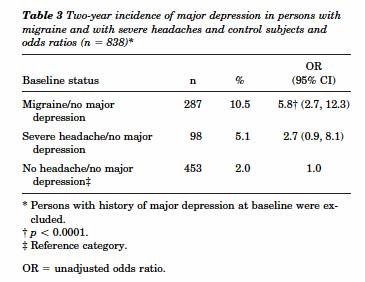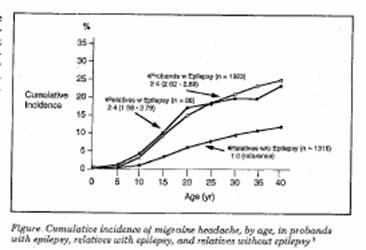8) Breslau N, Lipton RB, Stewart WF et al. Comorbidity of
migraine and depression: Investigating potential etiology and
prognosis. Neurology. 2003; 60:1308-1312
論文抄録
BACKGROUND: An association between migraine and major depression has been observed in clinical and community samples. The factors that contribute to this association and their implications remain unclear. OBJECTIVE: To determine the factors contributing to the association of migraine and major depression. METHODS: A cohort study of persons aged 25 to 55 years with migraine (n = 496) or with other headaches of comparable severity (n = 151) and control subjects with no history of severe headaches (n = 539) randomly selected from the general community were interviewed first in 1997 and then reinterviewed in 1999. RESULTS: Major depression at baseline predicted the first-onset migraine during the 2-year follow-up period (odds ratio [OR] = 3.4; 95% CI = 1.4, 8.7) but not other severe headaches (OR = 0.6; 95% CI = 0.1, 4.6). Migraine at baseline predicted the first-onset major depression during follow-up (OR = 5.8; 95% CI = 2.7, 12.3); the prospective association from severe headaches to major depression was not significant (OR = 2.7; 95% CI = 0.9, 8.1). Comorbid major depression did not influence the frequency of migraine attacks, their persistence, or the progression of migraine-related disability over time. CONCLUSIONS: Major depression increased the risk for migraine, and migraine increased the risk for major depression. This bidirectional association, with each disorder increasing the risk for first onset of the other, was not observed in relation to other severe headaches. With respect to other severe headaches, there was no increased risk associated with pre-existing major depression, although the possibility of an influence in the reverse direction (i.e., from severe headaches to depression) cannot be securely ruled out
文献 PubMed−ID
PM:12707434
エビデンスレベル
IIb
文献タイトル (日本語)
片頭痛と抑うつの同時罹患率:潜在的病因と予後調査
目的
片頭痛と大うつ病の合併に関与する因子を特定すること
研究デザイン
前向きコホート研究
研究施設
Departments of Psychiatry and Biostatistics and Research Epidemiology, Henry Ford Health System, Detroit .
Department of Psychiatry, University of Michigan School of Medicine, Ann Arbor; Department of Psychiatry, Case Western Reserve University, Cleveland, OH;
Innovative Medical Research and Departments of Neurology and Epidemiology and
Social Medicine, Albert Einstein College of Medicine, New York , NY ,
Department of Epidemiology, Johns Hopkins University , Baltimore , MD ; and University of Kansas Medical Center , Kansas City.
研究期間
1997年〜2003年(観察期間 1997〜1999年)
対象患者
25〜55才の片頭痛患者(n = 496),片頭痛に匹敵する重症度の他の頭痛の患者(n = 151),無作為抽出した重度の頭痛の既往がない対照地域住民(n = 539)を,1997年面接調査を実施し,2年後の1999年に再度面接調査した
介入
2年間のコホート調査
主要評価項目とそれに用いた統計学的手法
片頭痛,他の重度頭痛と大うつ病の既往と 2年間の新規の発症.
オッズ比( OR)を用いて解析
性別と大うつ病以外の共存精神障害によって補正した ORは、多変量ロジスティック回帰によって推定.
結果
大うつ病があると 2年以内の片頭発症は OR = 3.4(95%CI; 1.4-8.7,他の重度頭痛発症はOR = 0.6 (95%CI; 0.1 - 4.6)であった.

Migraine at baseline predicted the first-onset major depression during follow-up (OR = 5.8; 95% CI = 2.7, 12.3);
片頭痛があると 2年以内に大うつ病を発症するリスクはOR = 5.8 (95%のCI 2.7-2.3)で有意に高かった.重度の非片頭痛性頭痛からの大うつ病の合併は有意でなかった(OR = 2.7; 95% CI = 0.9- 8.1).

大うつ病の共存は、片頭痛発作の頻度,持続時間,他の片頭痛関連障害への進展に有意な影響は示さなかった.
結論
• 大うつ病は片頭痛の発症リスクを増加させ,片頭痛は大うつ病の発症リスクを増加させた.
• この双方向性の有意な合併の相関は 片頭痛以外の重度の頭痛では観察されない.
• 片頭痛以外の重度の頭痛に関しては,大うつ病の存在が片頭痛以外の頭痛の重度の頭痛を発症するリスクを増加させないが,逆方向,すなわち重度頭痛から大うつ病への可能性は完全には否定できなかった.
コメント
中規模の良質な前向きコホート研究.観察期間が 2年間とやや短い.
備考
Neurology601308.pdf
作成者
竹島多賀夫
